一、类的由来与简介
1. 简介
- 很早很早之前,在
JavaScript的世界里,生成实例对象的传统方法是通过构造函数。
嗯哼?
function Point(x, y) {
this.x = x;
this.y = y;
}
Point.prototype.toString = function () {
return '(' + this.x + ', ' + this.y + ')';
};
var p = new Point(1, 2);
运行查看:
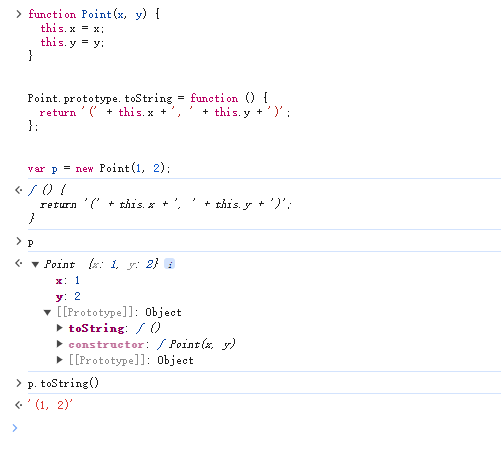
这种写法就很JavaScript,尤其是prototype,理解起来会很绕。
- 于是乎:
ES6中的class就诞生了。
以后可以通过class关键字,可以定义类。
基本上,ES6的class可以看作只是一个语法糖,它的绝大部分功能,ES5都可以做到,新的class写法只是让对象原型的写法更加清晰、更像面向对象编程的语法而已。上面的代码用ES6的class改写,就是下面这样:
class Point {
constructor(x, y) {
this.x = x;
this.y = y;
// }, 注意:不要加(','),否则报错
}
toString() {
return '(' + this.x + ', ' + this.y + ')';
}
}
var p = new Point(1, 2);
运行如图:
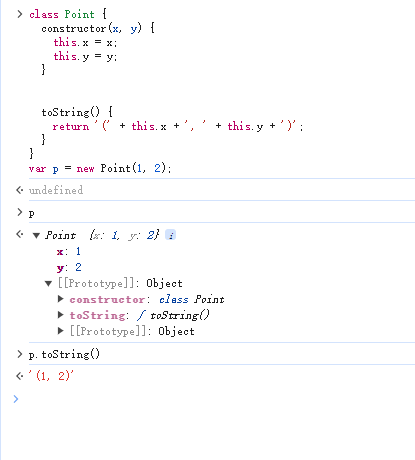
可以看到里面有一个 constructor 方法,这就是构造方法,而 this 关键字则代表实例对象。也就是说,ES5 的构造函数 Point ,对应 ES6 的 Point 类的构造方法。
- 继续向下看:
p是两位方式创建的实例对象:Point构造函数在原型上绑定添加toString方法,要使用:Point.prototype.toString = fn()- 构造函数创建的原型访问:
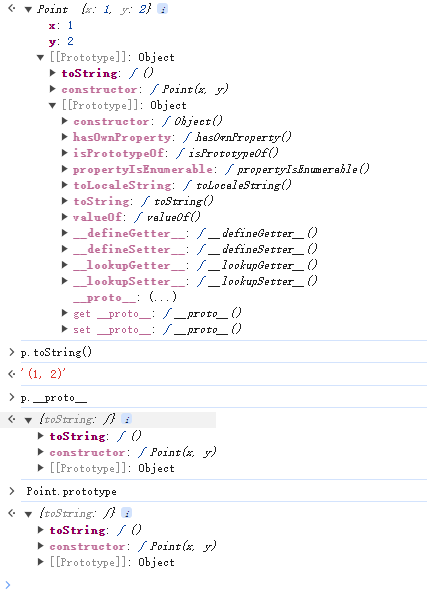
Point类呢,定义toString方法,前面不仅没有加function这个关键字,直接把函数定义放到constructor`构造方法同级里。竟然就能直接添加到原型上了,所以:类的所有方法都定义在类的 prototype 属性上面。class类创建的原型访问:
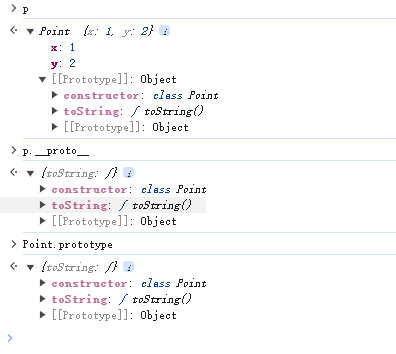
嗯哼,这糖甜不甜?
typeof Point = 'function'类的数据类型就是函数,
Point === Point.prototype.constructor // true类本身就指向构造函数。
2.constructor 方法
constructor方法是类的默认方法,通过new命令生成对象实例时,自动调用该方法。一个类必须有constructor方法,如果没有显式定义,一个空的constructor方法会被默认添加。
class Point {
}
// 定义了一个空的类 Point ,JavaScript 引擎会自动为它添加一个空的 constructor 方法。
// 等同于
class Point {
constructor() {}
}
constructor方法默认返回实例对象(即this),可以自定义返回内容。
class Foo {
constructor() {
return {};
}
}
new Foo() instanceof Foo // false
constructor 函数返回一个全新的对象,结果导致实例对象不是 Foo 类的实例。
- 类必须使用
new调用,否则会报错。

3. 类的实例
- 实例的属性除非显式定义在其本身(即写在
constructor内定义在this对象上),否则都是定义在原型上。
//定义类
class Point {
constructor(x, y) {
this.x = x;
this.y = y;
}
toString() {
return '(' + this.x + ', ' + this.y + ')';
}
}
var point = new Point(2, 3);
point.toString() // (2, 3)
point.hasOwnProperty('x') // true
point.hasOwnProperty('y') // true
point.hasOwnProperty('toString') // false
point.__proto__.hasOwnProperty('toString') // true
- 类的所有实例共享一个原型对象
var p1 = new Point(2,3);
var p2 = new Point(3,2);
p1.__proto__ === p2.__proto__ // true
p1 和 p2 都是 Point 的实例,它们的原型都是 Point.prototype ,所以 proto 属性是相等的。
4. 取值函数(getter)和存值函数(setter)
“类”的内部可以使用 get和 set关键字,对某个属性设置存值函数和取值函数,拦截该属性的存取行为。
class MyClass {
get prop() {
return 'getter';
}
set prop(value) {
console.log('setter: '+value);
}
}
let inst = new MyClass();
inst.prop = 123; // setter: 123
inst.prop // 'getter'
所以举个栗子:
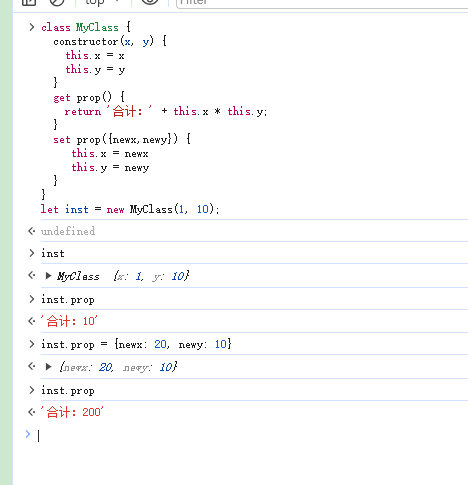
5. 属性表达式
类的属性名,可以采用表达式。
let methodName = 'getArea';
class Square {
constructor(length) {
// ...
}
[methodName]() {
// ...
}
}
效果图:
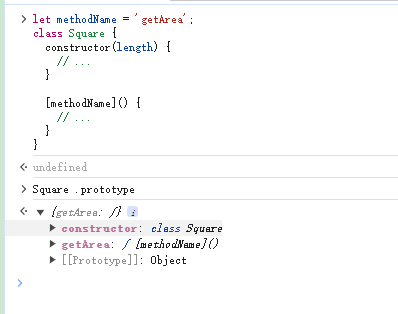
6. Class 表达式
与函数一样,类也可以使用表达式的形式定义。
const MyClass = class Me {
getClassName() {
return Me.name;
}
};
上面代码使用表达式定义了一个类。需要注意的是,这个类的名字是 Me ,但是 Me 只在 Class 的内部可用,指代当前类。在 Class 外部,这个类只能用 MyClass 引用。
let inst = new MyClass();
inst.getClassName() // Me
Me.name // ReferenceError: Me is not defined
上面代码表示, Me 只在 Class 内部有定义。
如果类的内部没用到的话,可以省略 Me ,也就是可以写成下面的形式。
const MyClass = class { /* ... */ };
采用 Class 表达式,可以写出立即执行的 Class。
let person = new class {
constructor(name) {
this.name = name;
}
sayName() {
console.log(this.name);
}
}('张三');
person.sayName(); // "张三"
7. 注意
- 严格模式
类和模块的内部,默认就是严格模式,所以不需要使用use strict指定运行模式。只要你的代码写在类或模块之中,就只有严格模式可用。 - 不存在提升
类不存在变量提升(hoist)。
new Foo(); // ReferenceError
class Foo {}
name属性
name属性总是返回紧跟在class关键字后面的类名
class Point {}
Point.name // "Point"
效果图:
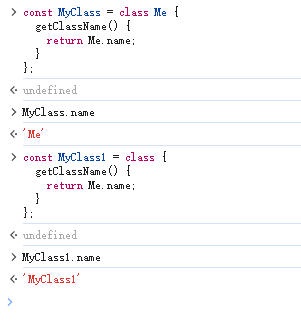
this的指向
类的方法内部如果含有this,它默认指向类的实例。但是,必须非常小心,一旦单独使用该方法,很可能报错。
class Logger {
printName(name = 'there') {
this.print(`Hello ${name}`);
}
print(text) {
console.log(text);
}
}
const logger = new Logger();
const { printName } = logger;
printName(); // TypeError: Cannot read property 'print' of undefined
上面代码中, printName 方法中的 this ,默认指向 Logger 类的实例。但是,如果将这个方法提取出来单独使用, this 会指向该方法运行时所在的环境(由于 class 内部是严格模式,所以 this 实际指向的是 undefined ),从而导致找不到 print 方法而报错。
- 一个比较简单的解决方法是,在构造方法中绑定
this,这样就不会找不到print方法了。
class Logger {
constructor() {
this.printName = this.printName.bind(this);
}
// ...
}
- 另一种解决方法是使用箭头函数。
class Obj {
constructor() {
this.getThis = () => this;
}
}
const myObj = new Obj();
myObj.getThis() === myObj // true
箭头函数内部的 this 总是指向定义时所在的对象。上面代码中,箭头函数位于构造函数内部,它的定义生效的时候,是在构造函数执行的时候。这时,箭头函数所在的运行环境,肯定是实例对象,所以 this 会总是指向实例对象。
二、 静态方法
- 类相当于实例的原型,所有在类中定义的方法,都会被实例继承。如果在一个方法前,加上
static关键字,就表示该方法不会被实例继承,而是直接通过类来调用,这就称为“静态方法”。
class Foo {
static classMethod() {
return 'hello';
}
}
Foo.classMethod() // 'hello'
var foo = new Foo();
foo.classMethod()
Foo 类的 classMethod 方法前有 static 关键字,表明该方法是一个静态方法,可以直接在 Foo 类上调用( Foo.classMethod() ),而不是在 Foo 类的实例上调用。如果在实例上调用静态方法,会抛出一个错误,表示不存在该方法。
- 如果静态方法包含
this关键字,这个this指的是类,而不是实例。
class Foo {
static bar() {
this.baz();
}
static baz() {
console.log('hello');
}
baz() {
console.log('world');
}
}
Foo.bar() // hello
上面代码中,静态方法 bar 调用了 this.baz ,这里的 this 指的是 Foo 类,而不是 Foo 的实例,等同于调用 Foo.baz 。另外,从这个例子还可以看出,静态方法可以与非静态方法重名。
- 父类的静态方法,可以被子类继承。
class Foo {
static classMethod() {
return 'hello';
}
}
class Bar extends Foo {
}
Bar.classMethod() // 'hello'
- 静态方法也是可以从
super对象上调用的。
class Foo {
static classMethod() {
return 'hello';
}
}
class Bar extends Foo {
static classMethod() {
return super.classMethod() + ', too';
}
}
Bar.classMethod() // "hello, too"
三、实例属性的新写法
实例属性除了定义在constructor()方法里面的 this 上面,也可以定义在类的最顶层。
class IncreasingCounter {
constructor() {
this._count = 0;
}
get value() {
console.log('Getting the current value!');
return this._count;
}
increment() {
this._count++;
}
}
上面代码中,实例属性 this._count 定义在 constructor() 方法里面。另一种写法是,这个属性也可以定义在类的最顶层,其他都不变。
class IncreasingCounter {
_count = 0;
get value() {
console.log('Getting the current value!');
return this._count;
}
increment() {
this._count++;
}
}